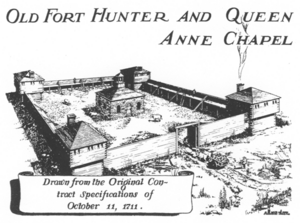Fort Hunter, New York facts for kids
Fort Hunter is a small community, called a hamlet, located in the Town of Florida in Montgomery County, New York. It sits west of the state capital, Albany. You can find it on the south bank of the Mohawk River and the northeast bank of Schoharie Creek.
This hamlet grew up around a fort with the same name. English colonists built the fort in 1712. It was near the Mohawk village of Tionondoroge. The fort was built to help defend the Mohawk people. Queen Anne ordered the fort built after the Mohawk asked for it. In return, the Mohawk allowed her to settle German Palatines in their territory. The English called the Mohawk settlement the Lower Mohawk Castle. Within a few years, the fort had an Anglican chapel. It was first made of logs, then replaced by a stone church in 1741. This church served as a mission for both the Mohawk and English settlers. The fort survived many wars in the area. It was taken down in 1820 to make way for the Erie Canal.
Contents
History of Fort Hunter
Land for the Fort
The land where Fort Hunter was built was about 80 acres. It was on both sides of the mouth of the Schoharie Creek. This land was given in 1697 to a man named Jan Peterse Mabee. He had an advantage because his wife, Anna Borsboom, was related to the local Mohawk people. A Mohawk leader, Sachem Rode of the Wolf Clan, signed the land deed. To build the fort, the Mabee family traded their land for new land further south on Schoharie Creek. Copies of this important land deed are kept in the Albany State Archives and at the shrine of Saint Kateri Tekakwitha in nearby Auriesville, New York.
Palatine Settlers Arrive
The area where Fort Hunter was built was near the easternmost of the two main Mohawk villages at that time. The fort was partly built to protect the nearby Mohawk village from the French and their Native American allies. The Mohawk village had several names, like Tionondoroge or Lower Mohawk Castle. The other main Mohawk village, Canajoharie, was known as the Upper Mohawk Castle. It was located further west along the Mohawk River.
Hendrick Tejonihokarawa of the Wolf Clan was a Mohawk leader, or sachem. He was also known as Hendrick Peters. He was one of the "Four Mohawk Kings" who traveled to London in 1710 to meet with Queen Anne. These chiefs asked the Queen for Anglican missionaries. They wanted help to balance the French Catholic influence in the Iroquois Confederacy. They also asked for defenses against French soldiers. In 1711, the Queen agreed to build Fort Hunter near Tionondorage for defense. The fort included a chapel and a mission house. Queen Anne even donated special communion silver and sent two missionaries to the colony.
In return, Queen Anne asked Tejonihokarawa for help. She wanted to settle Palatine Germans. These were Protestant refugees who were working in English camps in the Hudson Valley. They had left their home in the Palatine region of Germany because of wars. Through Governor Hunter, the Mohawk leader made some Mohawk land available. These settlers eventually made their homes near Schoharie Creek.
Building Fort Hunter
English colonists finished building Fort Hunter in 1712. In 1723, about 100 German families were given land. This land was known as the Burnetsfield Patent. It was west of the rapids at Little Falls. These settlers acted as a protective barrier between the French and Iroquois, and the English settlements.
A log cabin was first used as a chapel inside the fort. At one point, there were 30 houses for Mohawk people within the fort's walls. The log chapel was replaced with a stone church in 1741. A parsonage (a house for the church leader) was later built outside the fort, and it still stands today. The fort was used by local residents for protection during the French and Indian War and the American Revolution.
The Erie Canal Arrives
In 1820, the fort and its church were taken down. This was done to make way for the construction of the Erie Canal. The Erie Canal greatly increased trade and travel through the Mohawk Valley.
Fort Hunter Today
Today, the hamlet of Fort Hunter is home to the Schoharie Crossing State Historic Site. This site includes the remains of the Schoharie Crossing. This was a special navigable aqueduct that carried the canal over the creek. You can also see part of a lock from the early 1800s. These are all part of the historic Erie Canal system along the Mohawk River.



